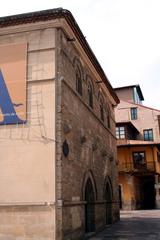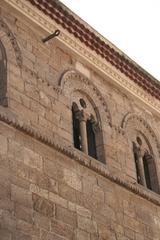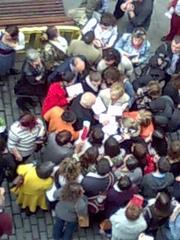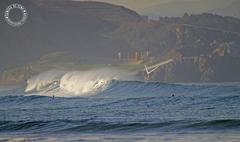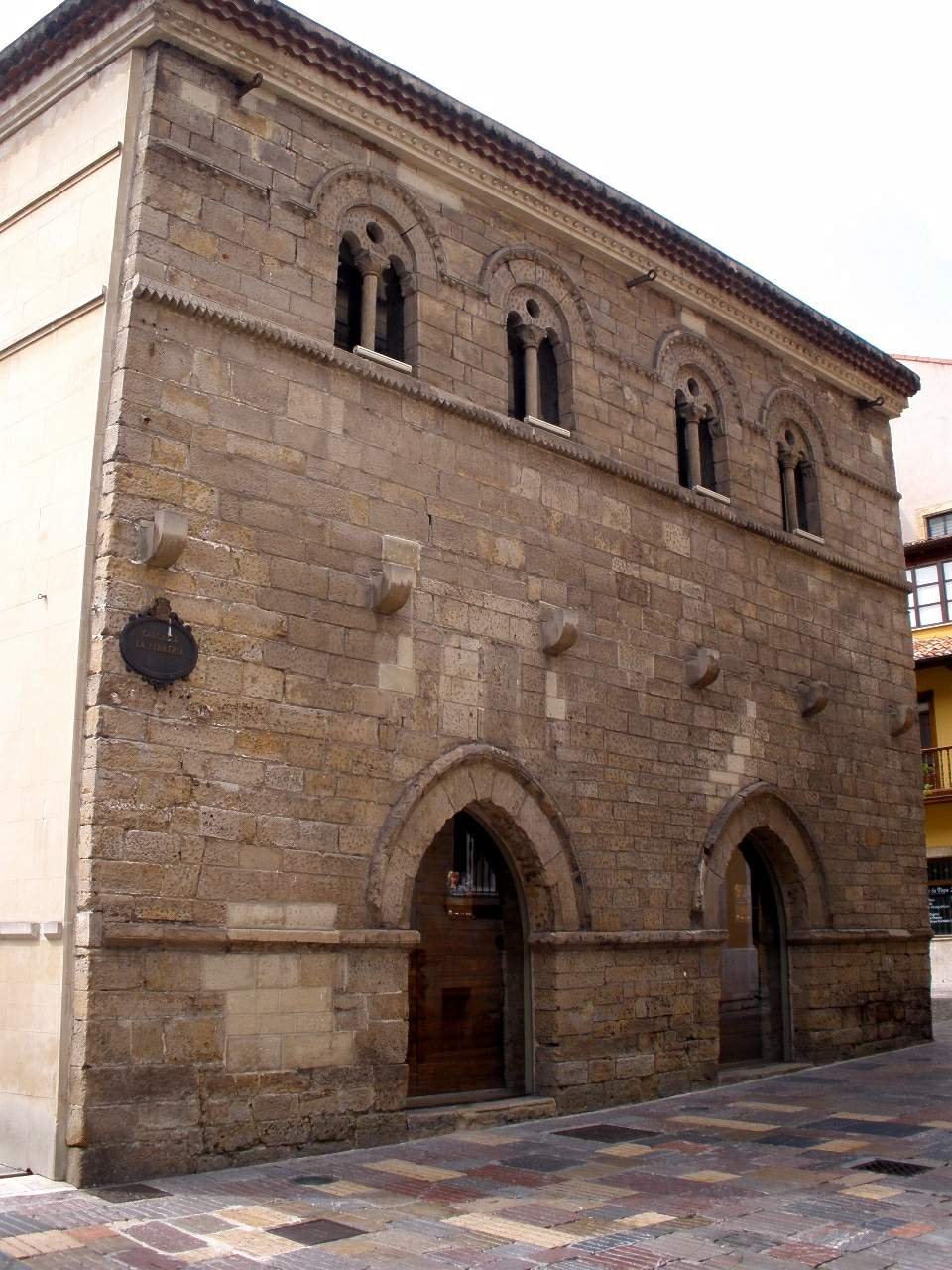
Palacio de Valdecarzana Visiting Guide: Hours, Tickets, and More
Date: 01/08/2024
Introduction
The Palacio de Valdecarzana, also known as Casa de las Baragañas, is an architectural and historical treasure located in the heart of Avilés, Asturias, Spain. As the oldest civilian building in the city and the sole example of non-religious Gothic architecture, it stands as a testament to the rich cultural and historical tapestry of Avilés. Constructed between the late 13th and early 14th centuries, this palace was originally commissioned by a wealthy local merchant to serve as both his residence and a commercial hub. Its strategic location at the intersection of Calle de la Ferrería and Calle del Sol adds to its prominence in the medieval landscape of Avilés (aviles.es).
Over the centuries, the Palacio de Valdecarzana has witnessed significant historical events, including a notable stay by King Pedro I of Castile in 1352. The building’s Gothic design, characterized by pointed arches, ribbed vaults, and flying buttresses, along with its functional layout, offers a fascinating glimpse into the architectural and social dynamics of medieval Spain. Today, the palace has been meticulously restored and repurposed as the Municipal Archive of Avilés, housing historical documents and hosting cultural events. This transformation, coupled with the ongoing preservation efforts, ensures that the Palacio de Valdecarzana remains a vibrant part of Avilés’ cultural scene (theorangebackpack.nl).
This comprehensive guide aims to provide prospective visitors with all the essential information needed to explore the Palacio de Valdecarzana. From its historical background and architectural highlights to practical visitor information and nearby attractions, this guide covers everything you need to know to make the most of your visit to this remarkable historical site.
Table of Contents
- Introduction
- Historical Background
- Architectural Features
- Visitor Information
- Historical Significance
- Preservation Efforts
- Nearby Attractions
- FAQ
- Conclusion
Historical Background
The Palacio de Valdecarzana, constructed between the late 13th and early 14th centuries, stands as the oldest civilian building in Avilés and the only example of non-religious Gothic architecture in the city (aviles.es). The palace was commissioned by a wealthy merchant from Avilés, who intended it to serve as his private residence. This historical edifice is located at the corner of Calle de la Ferrería and Calle del Sol, making it a prominent feature in the city’s medieval landscape.
Architectural Features
Gothic Elements
The Palacio de Valdecarzana is a prime example of Gothic architecture, characterized by its pointed arches, ribbed vaults, and flying buttresses. One of the most striking features of the palace is its twin windows on the first floor, which have been preserved in excellent condition (aviles.es). These windows are a testament to the Gothic style, showcasing intricate stonework and a sense of verticality that is typical of the period.
Structural Layout
The building originally served a dual purpose: the ground floor was used as a shop and storage area for the merchant’s goods, while the upper floor was reserved for residential use. This functional design reflects the economic activities of the time, where merchants often combined their living and working spaces. The palace’s layout is a clear indication of the social and economic status of its original owner, who was a prominent figure in Avilés’ mercantile community (theorangebackpack.nl).
Roof and Cornice
The roof of the Palacio de Valdecarzana is another noteworthy feature. It includes a cornice decorated with small balls, above which sits an eave with three rows of tiles. This roof design is believed to be a later addition, possibly from the 18th century, indicating that the building underwent modifications over the centuries (aviles.es).
Visitor Information
Visiting Hours and Tickets
The Palacio de Valdecarzana is open to visitors from Tuesday to Sunday, 10:00 AM to 7:00 PM. The palace is closed on Mondays and public holidays. Admission is free, but donations are welcome to support ongoing preservation efforts. Guided tours are available for a small fee, providing deeper insights into the palace’s history and architecture.
Location and Accessibility
The Palacio de Valdecarzana is conveniently located in the heart of Avilés at Calle del Sol, 1, 33402 Avilés. Its central location allows tourists to explore other nearby attractions, such as the Iglesia de Santo Tomás de Cantorbery and the Palacio de Camposagrado (wanderlog.com). The palace is wheelchair accessible, ensuring that all visitors can enjoy its historical and architectural wonders.
Exhibitions and Events
The palace’s transformation into a cultural center means that visitors can enjoy a variety of exhibitions and events. The exhibition halls feature displays related to the arts, history, and science, offering a diverse range of experiences for visitors. The auditorium hosts lectures, performances, and other cultural activities, making the Palacio de Valdecarzana a vibrant part of Avilés’ cultural scene (aviles.es).
Architectural Tours
For those interested in architecture, guided tours of the Palacio de Valdecarzana provide an in-depth look at its Gothic features and historical significance. These tours often include detailed explanations of the building’s design, construction techniques, and the historical context in which it was built. Visitors can gain a deeper appreciation of the palace’s architectural beauty and its role in the history of Avilés (theorangebackpack.nl).
Historical Significance
Royal Connection
The Palacio de Valdecarzana holds a special place in the history of Avilés due to its association with King Pedro I of Castile, also known as Pedro the Cruel. In 1352, Pedro I stayed at the palace while he liberated Avilés from the siege laid by his half-brother, Enrique de Trastámara. This event is a significant chapter in the history of Avilés, highlighting the palace’s role as a refuge and a symbol of royal favor (aviles.es).
Cultural and Civic Role
In 1997, the Palacio de Valdecarzana underwent a major restoration under the direction of architect Julio L. Redondo. The restoration aimed to preserve the building’s historical integrity while adapting it for modern use. By 2000, the palace had been transformed into the Municipal Archive of Avilés, housing important historical documents and serving as a cultural hub. The building now includes exhibition halls and an auditorium, hosting various artistic and cultural events (aviles.es).
Preservation Efforts
Restoration Projects
The restoration of the Palacio de Valdecarzana in the late 20th century was a significant effort to preserve its historical and architectural integrity. The project involved careful conservation of the building’s original features, such as the Gothic windows and the decorative cornice. Modern interventions were designed to be sympathetic to the original architecture, ensuring that the palace retained its historical character while meeting contemporary needs (aviles.es).
Ongoing Maintenance
Maintaining a historical building like the Palacio de Valdecarzana requires ongoing efforts to address issues such as structural stability, weathering, and wear and tear. The local government and cultural organizations in Avilés are committed to preserving the palace for future generations. Regular inspections and maintenance work are carried out to ensure that the building remains in good condition and continues to serve as a cultural landmark (aviles.es).
Nearby Attractions
When visiting the Palacio de Valdecarzana, tourists can also explore nearby attractions that add to the rich historical and cultural experience of Avilés. Notable sites include the Iglesia de Santo Tomás de Cantorbery, the Palacio de Camposagrado, and the Centro Niemeyer. These sites offer a glimpse into the varied architectural styles and historical narratives that shape Avilés (wanderlog.com).
FAQ
What are the visiting hours for Palacio de Valdecarzana?
The palace is open from Tuesday to Sunday, 10:00 AM to 7:00 PM, and is closed on Mondays and public holidays.
Is there an admission fee?
Admission is free, but donations are welcome to support preservation efforts. Guided tours are available for a small fee.
Is the palace wheelchair accessible?
Yes, the Palacio de Valdecarzana is wheelchair accessible.
Are there guided tours available?
Yes, guided tours are available and provide detailed insights into the palace’s history and architecture.
Conclusion
The Palacio de Valdecarzana is a remarkable example of Gothic architecture and a significant historical landmark in Avilés. Its rich history, architectural beauty, and cultural significance make it a must-visit destination for anyone interested in the history and heritage of Asturias. Whether exploring its Gothic features, attending a cultural event, or delving into its historical archives, visitors to the Palacio de Valdecarzana are sure to have a memorable experience. For more information and updates, follow our social media channels or download the Audiala mobile app.

